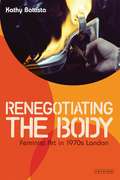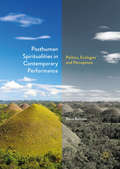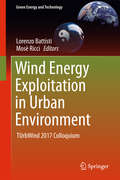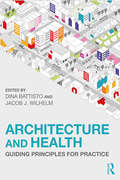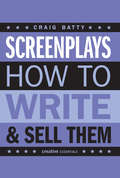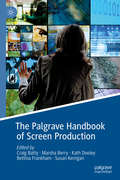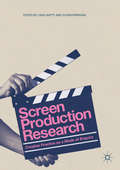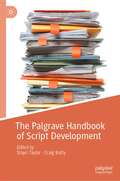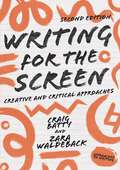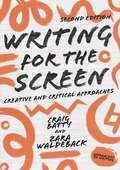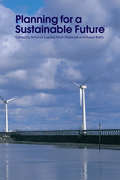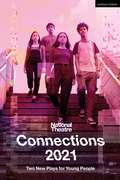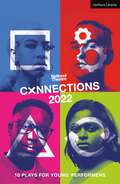- Table View
- List View
New York New Wave: The Legacy of Feminist Art in Emerging Practice (International Library of Modern and Contemporary Art)
by Kathy BattistaNew York is a centre of creative production for an exciting, emerging generation of women artists. Their work investigates themes such as the body as medium and subject matter; the deconstruction of the existing patriarchal order of the art world; the appropriation of earlier art historical references; and the use of so-called abject and everyday materials. New York New Wave investigates the relevance of earlier feminist practice for this 'new' generation, asking: Does gender difference still play a role in today's practice? How can younger women artists embrace a radical political ideology and yet remain market friendly? How far have these artists diverged from the established feminist "tradition"? Artists discussed include: Firelei Baez, EV Day, Ruby LaToya Fraser, Diana Al-Hadid, K8 Hardy, Valerie Hegarty, Cindy Hinant, Dawn Kasper, Anya Kielar, Liz Magic Laser, Narcissister, Alix Pearlstein, Aurel Schmidt, AL Steiner and W.A.G.E.
New York New Wave: The Legacy of Feminist Art in Emerging Practice (International Library of Modern and Contemporary Art)
by Kathy BattistaNew York is a centre of creative production for an exciting, emerging generation of women artists. Their work investigates themes such as the body as medium and subject matter; the deconstruction of the existing patriarchal order of the art world; the appropriation of earlier art historical references; and the use of so-called abject and everyday materials. New York New Wave investigates the relevance of earlier feminist practice for this 'new' generation, asking: Does gender difference still play a role in today's practice? How can younger women artists embrace a radical political ideology and yet remain market friendly? How far have these artists diverged from the established feminist "tradition"? Artists discussed include: Firelei Baez, EV Day, Ruby LaToya Fraser, Diana Al-Hadid, K8 Hardy, Valerie Hegarty, Cindy Hinant, Dawn Kasper, Anya Kielar, Liz Magic Laser, Narcissister, Alix Pearlstein, Aurel Schmidt, AL Steiner and W.A.G.E.
Renegotiating the Body: Feminist Art in 1970s London
by Kathy BattistaWhat makes art 'feminist art'? Although feminist artists do have a unique aesthetic, there can be no essential feminist aesthetic, argues Kathy Battista in this exciting new art history. Domesticity, the body, its traces and sexuality have become prominent themes in contemporary feminist practice but where did these preoccupations begin and how did they come to signify a particular type of art? Kathy Battista's (re-)engagement with the founding generation of female practitioners centres on 1970s London as the cultural hub from which a new art practice arose. Emphasising the importance of artists including Bobby Baker, Anne Bean, Catherine Elwes, Rose English, Alexis Hunter, Tina Keane, Hannah O'Shea, Kate Walker and Silvia Ziranek and examining works such as Mary Kelly's Post-Partum Document, Judy Clark's 1973 exhibition Issues, Carolee Schneemann's Meat Joy and Cosey Fanni Tutti's Prostitution, shown in 1976, Kathy Battista investigates some of the most controversial and provocative art from the era. This book not only deals with the 'famous' art events but includes analysis of lesser-known exhibitions and performances and explains why so much feminist art has been both marginalised in art history and grossly under-represented in institutional archives and collections.
Posthuman Spiritualities in Contemporary Performance: Politics, Ecologies and Perceptions
by Silvia BattistaThis book provides an interpretative analysis of the notion of spirituality through the lens of contemporary performance and posthuman theories. The book examines five performance/artworks: The Artist is Present (2010) by Marina Abramović; The Deer Shelter Skyscape (2007) by James Turrell; CAT (1998) by Ansuman Biswas; Journey to the Lower World by Marcus Coates (2004); and the work with pollen by Wolfgang Laib. Through the analysis of these works the notion of spirituality is grounded in materiality and embodiment allowing the conceptual juxtaposition of spirit and matter to introduce the paradoxical as the guiding thread of the narrative of the book. Here, the human is interrogated and negotiated with/within a plurality of other living organisms, intangible existences and micro and macrocosmic ecologies. Silence, meditation, shamanic journeys, reciprocal gazing, restraint, and contemplation are analyzed as technologies used to manipulate perception and adventure into the multilayered condition of matter.
Posthuman Spiritualities in Contemporary Performance: Politics, Ecologies and Perceptions
by Silvia BattistaThis book provides an interpretative analysis of the notion of spirituality through the lens of contemporary performance and posthuman theories. The book examines five performance/artworks: The Artist is Present (2010) by Marina Abramović; The Deer Shelter Skyscape (2007) by James Turrell; CAT (1998) by Ansuman Biswas; Journey to the Lower World by Marcus Coates (2004); and the work with pollen by Wolfgang Laib. Through the analysis of these works the notion of spirituality is grounded in materiality and embodiment allowing the conceptual juxtaposition of spirit and matter to introduce the paradoxical as the guiding thread of the narrative of the book. Here, the human is interrogated and negotiated with/within a plurality of other living organisms, intangible existences and micro and macrocosmic ecologies. Silence, meditation, shamanic journeys, reciprocal gazing, restraint, and contemplation are analyzed as technologies used to manipulate perception and adventure into the multilayered condition of matter.
ETHICS: Cross-disciplinary Strategies (Designing Environments)
by Alessandra Battisti Serena BaianiThis book outlines, within the Italian national framework, the current and potential paths oriented towards a new concept of Architectural Heritage, through actions referring to Innovation and Experimentation and Protection and Transformation of the Architectural Heritage. The development of the themes is articulated in two sessions dealing with the aspects related to the analysis and mapping of Architectural Heritage to face the context of the current Climate Crisis and the development of projects and experimentations oriented to the Green and Digital Transition. The evolution of the concept of Heritage, as conceived by the United Nations 2030 Agenda and in the Green Deal and New European Bauhaus, aimed at constructing an inclusive and universally recognised definition to support supranational objectives of sustainable human development, gives rise to innovative strategies, methodologies and technologies that—in a direction of mitigation, contrast and adaptation to climate change—allow for the safeguard, renewed management and a hope for valorisation of Heritage on a national scale. In this direction, the understanding of Architectural Heritage as a 'non-renewable resource' determines the need to activate design experimentation laboratories oriented towards regeneration, articulated and complex, which require, in order to respond to the challenges posed by our era, a sensitive and dialogic multidisciplinary vision of a holistic type. In fact, on the one hand, it is necessary to redefine the usability and management methods of built heritage through the adoption of digital, mobility, energy, ecological, social, green and blue infrastructures; on the other hand, it is necessary to introduce new qualitative and quantitative parameters and performance indicators, adequate to verify the validity of the implemented strategies in a perspective of adaptation to climate change, able to clarify contents, processes and tools to contrast future risks. The pursuit of these objectives refers to the innovation of training paths, professionalising procedures, administrative regulations, and public policies that involve citizens and the private partnership towards a different project qualification and empowerment of stakeholders, inhabitants, professionals, and clients. The Technological Project makes it possible to activate different interventions aimed at acting, in an integrated manner, on assets, context and communities, according to an approach that reinterprets them on a common score, as proposed by the European Next Generation programme in three priority aspects: digitalisation and innovation, environmental transition, increased resilience and social sustainability of national economies. In this scenario, the interventions aimed at outlining sustainable development actions will have to place these concepts at the centre in a harmonious vision that starts from the recognition and enhancement of the Architectural Heritage, recognising it as a fundamental asset of the territories.
Wind Energy Exploitation in Urban Environment: TUrbWind 2017 Colloquium (Green Energy and Technology)
by Lorenzo Battisti Mosè RicciThis book presents numerical and experimental research in the field of wind energy exploitation in urban environments. It comprises a selection of the best papers from the international colloquium “Research and Innovation on Wind Energy Exploitation in Urban Environment” (TUrbWind), held in Riva del Garda, Italy in June 2017. The book includes contributions from different research fields in urban wind resources, wind energy conversion systems, and urban integration, mainly focusing on the following topics: · concepts for urban and open landscape micro wind turbines, · integration of micro wind turbines in existing structures, · built-environment and high-turbulence sites’ impacts on urban wind turbines, · measuring and modeling wind resource in built environments, · rotor performance and wake features of micro wind turbines. It is a valuable resource for researchers and practitioners interested in the integration of wind energy systems and turbines in urban areas.
Architecture and Health: Guiding Principles for Practice
by Dina Battisto Jacob J. WilhelmArchitecture and Health recognizes the built environment and health as inextricable encouraging a new mind-set for the profession. Over 40 international award-winning projects are included to explore innovative design principles linked to health outcomes. The book is organized into three interdependent health domains—individual, community, and global—in which each case study proposes context-specific architectural responses. Case studies include children’s hospitals, rehabilitation facilities, elderly housing, mental health facilities, cancer support centers, clinics, healthy communities, healthcare campuses, wellness centers, healing gardens, commercial offices, infrastructure for developing countries, sustainable design, and more. Representing the United States, Africa, Asia, Europe, and Australia, each author brings a new perspective to health and its related architectural response. This book brings a timely focus to a subject matter commonly constricted by normative building practices and transforms the dialogue into one of creativity and innovation. With over 200 color images, this book is an essential read for architects, designers, and students to explore and analyze designed environments that promote health and well-being.
Architecture and Health: Guiding Principles for Practice
by Dina Battisto Jacob J. WilhelmArchitecture and Health recognizes the built environment and health as inextricable encouraging a new mind-set for the profession. Over 40 international award-winning projects are included to explore innovative design principles linked to health outcomes. The book is organized into three interdependent health domains—individual, community, and global—in which each case study proposes context-specific architectural responses. Case studies include children’s hospitals, rehabilitation facilities, elderly housing, mental health facilities, cancer support centers, clinics, healthy communities, healthcare campuses, wellness centers, healing gardens, commercial offices, infrastructure for developing countries, sustainable design, and more. Representing the United States, Africa, Asia, Europe, and Australia, each author brings a new perspective to health and its related architectural response. This book brings a timely focus to a subject matter commonly constricted by normative building practices and transforms the dialogue into one of creativity and innovation. With over 200 color images, this book is an essential read for architects, designers, and students to explore and analyze designed environments that promote health and well-being.
Movies That Move Us: Screenwriting and the Power of the Protagonist's Journey
by C. BattyFrom a screenwriting perspective, Batty explores the idea that the protagonist's journey is comprised of two individual yet interwoven threads: the physical journey and the emotional journey. His analysis includes detailed case studies of the films Muriel's Wedding , Little Voice , Cars , Forgetting Sarah Marshall , Sunshine Cleaning and Up.
Screenplays & how to write & sell them: How To Write And Sell Them (Writing And Selling Screenplays Ser.)
by Craig BattyScreenplays … How to Write and Market Them is an accessible yet comprehensive book aimed at those with a keen interest in writing feature film screenplays. Using case studies, creative exercises and interviews from the industry, the book will guide readers through the necessary stages of writing a screenplay, from finding and developing ideas to creating and executing characters to shaping structure and constructing scenes. It will also consider how a screenplay might be sold, or used to raise interest in the writer, looking at areas such as finding and working with an agent, networking, using competitions, and raising private production funds. The book's approach is both creative and reflective, giving readers the opportunity to learn a wealth of creative skills alongside skills that will encourage them to think about themselves as writers and the work that they are developing. As such, the book will empower readers in their own creative processes and allow them to successfully tell the stories they want to tell. Rich with analyses from classic and contemporary films, littered with practical models, paradigms and creative tasks, and enhanced by the views of key industry figures, the book is a must for any aspiring feature film screenwriter.
Screenwriters and Screenwriting: Putting Practice into Context
by Craig BattyScreenwriters and Screenwriting is an innovative, fresh and lively book that is useful for both screenwriting practice and academic study. It is international in scope, with case studies and analyses from the US, the UK, Australia, Japan, Ireland and Denmark. The book presents a distinctive collection of chapters from creative academics and critical practitioners that serve one purpose: to put aspects of screenwriting practice into their relevant contexts. Focusing on how screenplays are written, developed and received, the contributors challenge assumptions of what 'screenwriting studies' might be, and celebrates the role of the screenwriter in the creation of a screenplay. It is intended to be thought provoking and stimulating, with the ultimate aim of inspiring current and future screenwriting practitioners and scholars.
The Palgrave Handbook of Screen Production
by Craig Batty Marsha Berry Susan Kerrigan Kath Dooley Bettina FrankhamThis handbook is an essential creative, critical and practical guide for students and educators of screen production internationally. It covers all aspects of screen production—from conceptualizing ideas and developing them, to realizing and then distributing them—across all forms and formats, including fiction and non-fiction for cinema, television, gallery spaces and the web. With chapters by practitioners, scholars and educators from around the world, the book provides a comprehensive collection of approaches for those studying and teaching the development and production of screen content. With college and university students in mind, the volume purposely combines theory and practice to offer a critically informed and intellectually rich guide to screen production, shaped by the needs of those working in education environments where ‘doing’ and ‘thinking’ must co-exist. The Palgrave Handbook of Screen Production fills an important gap in creative-critical knowledge of screen production, while also providing practical tools and approaches for future practitioners.
Screen Production Research: Creative Practice as a Mode of Enquiry
by Craig Batty Susan KerriganAimed at students and educators across all levels of Higher Education, this agenda-setting book defines what screen production research is and looks like—and by doing so celebrates creative practice as an important pursuit in the contemporary academic landscape. Drawing on the work of international experts as well as case studies from a range of forms and genres—including screenwriting, fiction filmmaking, documentary production and mobile media practice—the book is an essential guide for those interested in the rich relationship between theory and practice. It provides theories, models, tools and best practice examples that students and researchers can follow and expand upon in their own screen production projects.
Screen Production Research: Creative Practice as a Mode of Enquiry
by Craig Batty Susan KerriganAimed at students and educators across all levels of Higher Education, this agenda-setting book defines what screen production research is and looks like—and by doing so celebrates creative practice as an important pursuit in the contemporary academic landscape. Drawing on the work of international experts as well as case studies from a range of forms and genres—including screenwriting, fiction filmmaking, documentary production and mobile media practice—the book is an essential guide for those interested in the rich relationship between theory and practice. It provides theories, models, tools and best practice examples that students and researchers can follow and expand upon in their own screen production projects.
The Palgrave Handbook of Script Development
by Craig Batty Stayci TaylorThe Palgrave Handbook of Script Development provides the first comprehensive overview of international script development practices. Across 40 unique chapters, readers are guided through the key challenges, roles and cultures of script development, from the perspectives of creators of original works, those in consultative roles and those giving broader contextual case studies. The authors take us inside the writers’ room, alongside the script editor, between development conversations, and outside the mainstream and into the experimental. With authors spanning upwards of 15 countries, and occupying an array of roles – including writer, script editor, producer, script consultant, executive, teacher and scholar, this is a truly international perspective on how script development functions (or otherwise) across media and platforms. Comprising four parts, the handbook guides readers behind the scenes of script development, exploring unique contexts, alternative approaches, specific production cultures and global contexts, drawing on interviews, archives, policy, case study research and the insider track. With its broad approach to a specialised practice, the Palgrave Handbook of Script Development is for anyone who practices, teaches or studies screenwriting and screen production.
Script Development: Critical Approaches, Creative Practices, International Perspectives
by Craig Batty Stayci TaylorThis book offers the first international look at how script development is theorised and practiced. Drawing on interviews, case studies, discourse analysis, creative practices and industry experiences, it brings together scholars and practitioners from around the world to offer critical insights into this core, but often hidden, aspect of screenwriting and screen production. Chapters speculate and reflect upon how creative, commercial and social practices – in which ideas, emotions, people and personalities combine, cohere and clash – are shaped by the practicalities, policies and rapid movements of the screen industry. Comprising two parts, the book first looks ‘into’ script development from a theoretical perspective, and second looks ‘out from’ the practice to form practitioner-led perspectives of script development. With a rising interest in screenwriting and production studies, and an increased appetite for practice-based research, the book offers a timely mapping of the terrain of script development, providing rich foundations for both study and practice.
The Creative Screenwriter: Exercises to Expand Your Craft
by Craig Batty Zara WaldebackThis is a book for aspiring screenwriters who want to establish a powerful writing practice; a manual for teachers and students seeking inspiring exercises to encourage discussion and reflection; and a handbook for professionals wanting to hone their craft and solve specific writing problems. It is a book that will help rekindle the creative spark, remind you why you enjoy writing, and create new ways to help you expertly express the stories you want to tell - and sell!
Writing for the Screen: Creative and Critical Approaches (Approaches to Writing)
by Craig Batty Zara WaldebackThis revised and refreshed edition guides the contemporary screenwriter through a variety of creative and critical approaches to a deeper understanding of how to tell stories for the screen. With a renewed focus on theme and structure, the book is an essential guide for writers, script developers and teachers to help develop ideas into rich dynamic projects, and craft compelling, resonating screenplays. Combining creative tools and approaches with critical and contextual underpinnings, the book is ideal for screenwriting students who are looking to expand their skills and reflect on practices to add greater depth to their scripts. It will also inspire experienced writers and developers to find fresh ways of working and consider how new technology is affecting storytelling voices. Comprehensive and engaging, this book considers key narrative questions of today and offers a range of exercises to address them. Integrating creative guidance with rigorous scholarship, this is the perfect companion for undergraduate students taking courses in screenwriting. Encouraging and pragmatic, it will provide a wealth of inspiration for those wishing to work in the industry or deepen their study of the practice.
Writing for the Screen: Creative and Critical Approaches
by Craig Batty Zara WaldebackThis revised and refreshed edition guides the contemporary screenwriter through a variety of creative and critical approaches to a deeper understanding of how to tell stories for the screen. With a renewed focus on theme and structure, the book is an essential guide for writers, script developers and teachers to help develop ideas into rich dynamic projects, and craft compelling, resonating screenplays. Combining creative tools and approaches with critical and contextual underpinnings, the book is ideal for screenwriting students who are looking to expand their skills and reflect on practices to add greater depth to their scripts. It will also inspire experienced writers and developers to find fresh ways of working and consider how new technology is affecting storytelling voices. Comprehensive and engaging, this book considers key narrative questions of today and offers a range of exercises to address them. Integrating creative guidance with rigorous scholarship, this is the perfect companion for undergraduate students taking courses in screenwriting. Encouraging and pragmatic, it will provide a wealth of inspiration for those wishing to work in the industry or deepen their study of the practice.New to this Edition:- Refreshed and revised edition to meet the demands of contemporary screenwriting- New case studies, models, tools and approaches to writing for the screen- Updated areas of industry practice, including web series, transmedia, VR and long-form storytelling- Includes practical approaches and creative exercises that can be used in the classroom
Planning for a Sustainable Future
by Sue Batty Simin Davoudi Antonia LayardSustainable Development is now firmly on the planning agenda and is an issue neither practitioner nor academic can afford to ignore. Planning for a Sustainable Future provides a multi-disciplinary overview of sustainability issues in the land use context, focusing on principles and their application, the legal, political and policy context and the implication of sustainable development thinking for housing, urban design and property development as well as waste and transport. The book concludes by considering how sustainable and unsustainable impacts alike can be measured and modelled, providing real tools to move beyond rhetoric into practice.
National Theatre Connections 2021: Two Plays for Young People (Modern Plays)
by Miriam Battye Belgrade Young CompanyIt is the scale and range of creative collaboration inherent in theatre that sits at the very heart of National Theatre Connections Drawing together the work of ten leading playwrights, National Theatre Connections 2021 features work by brilliant artists. These are plays for a generation of theatre-makers who want to ask questions, challenge assertions and test the boundaries, and for those who love to invent and imagine a world of possibilities. The plays offer young performers an engaging and diverse range of material to perform, read or study.This 2021 edition is intended as a companion to the 2020 anthology, which together represent the full set of 10 plays offered by the National Theatre 2021 Festival. The two plays included in this collection are Find a Partner by Miriam Battye and Like There's No Tomorrow, created by the Belgrade Young Company with Justine Themen, Claire Procter and Liz Mytton. The anthology contains two play scripts, as well as comprehensive workshop notes that will give insights and inspiration for building characters, running rehearsals and staging a production.
National Theatre Connections 2022: 10 Plays for Young Performers
by Miriam Battye Belgrade Young Company Stef Smith Katie Hims Abbey Wright Shireen Mula Matt Regan Lisa Goldman Ayeesha Menon David Judge Fionnuala Kennedy Tim CrouchIt is the scale and range of creative collaboration inherent in theatre that sits at the very heart of National Theatre Connections.National Theatre Connections 2022 draws together ten new plays for young people to perform, from some of the UK's most exciting playwrights. These are plays for a generation of theatre-makers who want to ask questions, challenge assertions and test the boundaries, and for those who love to invent and imagine a world of possibilities.The plays offer young performers an engaging and diverse range of material to perform, read or study.This 2022 anthology represents the full set of ten plays offered by the National Theatre 2022 Festival, as well as comprehensive workshop notes that give insights and inspiration for building characters, running rehearsals and staging a production.
National Theatre Connections 2022: 10 Plays for Young Performers
by Miriam Battye Belgrade Young Company Stef Smith Katie Hims Abbey Wright Shireen Mula Matt Regan Lisa Goldman Ayeesha Menon David Judge Fionnuala Kennedy Tim CrouchIt is the scale and range of creative collaboration inherent in theatre that sits at the very heart of National Theatre Connections.National Theatre Connections 2022 draws together ten new plays for young people to perform, from some of the UK's most exciting playwrights. These are plays for a generation of theatre-makers who want to ask questions, challenge assertions and test the boundaries, and for those who love to invent and imagine a world of possibilities.The plays offer young performers an engaging and diverse range of material to perform, read or study.This 2022 anthology represents the full set of ten plays offered by the National Theatre 2022 Festival, as well as comprehensive workshop notes that give insights and inspiration for building characters, running rehearsals and staging a production.
New Islamist Architecture and Urbanism: Negotiating Nation and Islam through Built Environment in Turkey (Architext)
by Bülent BatumanNew Islamist Architecture and Urbanism claims that, in today’s world, a research agenda concerning the relation between Islam and space has to consider the role of Islamism rather than Islam in shaping – and in return being shaped by – the built environment. The book tackles this task through an analysis of the ongoing transformation of Turkey under the rule of the pro-Islamic Justice and Development Party. In this regard, it is a topical book: a rare description of a political regime's reshaping of urban and architectural forms whilst the process is alive. Defining Turkey’s transformation in the past two decades as a process of "new Islamist" nation-(re)building, the book investigates the role of the built environment in the making of an Islamist milieu. Drawing on political economy and cultural studies, it explores the prevailing primacy of nation and nationalism for new Islamism and the spatial negotiations between nation and Islam. It discusses the role of architecture in the deployment of history in the rewriting of nationhood and that of space in the expansion of Islamist social networks and cultural practices. Looking at examples of housing compounds, mosques, public spaces, and the new presidential residence, New Islamist Architecture and Urbanism scrutinizes the spatial making of new Islamism in Turkey through comparisons with relevant cases across the globe: urban renewal projects in Beirut and Amman, nativization of Soviet modernism in Baku and Astana, the presidential palaces of Ashgabat and Putrajaya, and the neo-Ottoman mosques built in diverse locations such as Tokyo and Washington DC.

